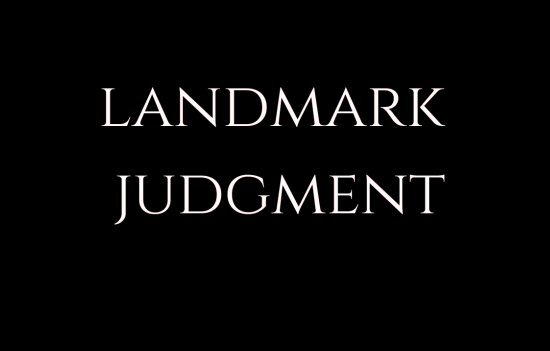CASE BRIEF
Appellant- A. Yousuf Rawther
Respondent- Sowramma
Decided On: 24.06.1970
Equivalent Citations:
- AIR 1971 Ker 261
Bench:
- V.K. Iyer
Statutes Referred:
- Dissolution of Muslim Marriages Act, Act 8 of 1939
- Child Marriage Restraint Act, 1935
- Special Marriage Act, Act 43 of 1954
Cases Referred:
- Mt. Ghulam Sakina v. Falak Sher Allah Baksh, (AIR 1950 Lah 45)
- Rabia Khatoon v. Mohd. Mukhtar Ahmad, (AIR 1966 All 548)
- Khurshid Bibi v. Mohd. Amin, PLD 1967 SC 97
- Mat. Balqis Fatima v. Najmul-Ikram, (1959) 2 (WP) p. 321 (1959 Lah 566)
- Ahmad Jan v. Mt. Sultan Bibi, (AIR 1943 Pesh 73)
- Mt. Zainaba v. Abdul Rahman, (AIR 1945 Pesh 51)
- Manak Khan v. Mt. Mulkhan Bano, (AIR 1941 Lah 167)
- Mt. Akbari Begum v. Zafar Hussain, (AIR 1942 Lah 92)
- Mt. Noor Bibi v. Pir Bux, (AIR 1950 Sind 8)
- Najiman Nissa Begum v. Serajuddin Ahmed Khan, (AIR 1946 Pat 467)
- Zafav Hussain v. Mt. Akbari Begum, (AIR 1944 Lah 336)
- Mt. Umat-ul-Hafiz v. Talib Hussain. (AIR 1945 Lah 56)
- Mst. Badrulnisa Bibi v. Mohammad Yusuf. (AIR 1944 All 23)
- Mt. Shamim Fatma v. Ahmad Ullah Khan. (AIR 1947 All 3)
- Khatijan v. Abdulla, (AIR 1943 Sind 65)
- Fazal Mahmud v. Mt. Umatur Rahim, (AIR 1949 Pesh 7
- Jamila Khatun v. Kasim Ali Abbas Ali, (AIR 1951 Nag 375)
- Amir Mohd. v. Mst. Bushra, (AIR 1956 Raj 102)
Facts:
- The plaintiff (defendant) had attained puberty even before the marriage with the appellant took place.
- Subsequent to the wedding, the bridal pair moved on to live in the husband’s house, immediately a day after which, the defendant (appellant) left for Coimbatore to run his radio dealer’s business.
- After a month of living in the house of the husband, due to reasons that are blamed by each on the other, the girl went back to her parents.
- Such separation lasted for two years, during which the defendant (appellant) admittedly failed to maintain the wife.
- The alleged ground sought by the defendant (appellant) was that he was willing and indeed, anxious to keep her with him but she wrongfully refused to return to the conjugal home, thanks to the objectional inhibition by the father of the girl.
- Finding the wife recalcitrant, the husband moved the mosque committee through his brother but such effort did not bring any fruit, as a result of which divorce was the only solution as reported by them.
- Litigation of dissolution erupted after preliminary skirmishes of lawyer notices. The suit was dismissed by the Trial Court but a decree for dissolution of the marriage was granted by the Subordinate Judge’s Court.
- This is an appeal by the aggrieved husband, challenging the validity of the lower appellate court.
Issue:
- Whether a dissolution of marriage can be claimed by the wife on the grounds of failure of the husband to maintain the erring wife for 2 years.
Ratio Decidendi:
- The reasoning of Tyabji (AIR 1943 Sind 65) accords with the holy Islamic texts and the ethos of the Muslim community which together serve as a backdrop for the proper understanding of the provisions of Act 8 of 1939. Further, this pragmatic and secular approach of the Muslim Law of divorce harmonizes happily with the contemporary concepts possessed by advanced countries.
- The law of the Marumakkathayees provides a large license for divorce but actual experience allays the alarm. The law has to provide for possibilities; social opinion regulates the probabilities.
- A Muslim woman can sue for dissolution, under Section 2 (ii) of the Act, on the ground that she has not, for a fact, been maintained even if there is good cause for it–the voice of the law echoing public policy is often that of the realist, not of the moralist.
Judgement:
- The appeal fails and is dismissed but without costs at any tier.
Conclusion:
The case put forward a seminal issue regarding the right of the wife to claim for the dissolution of marriage on the grounds of not receiving maintenance for two years. An examination of the relevant provisions and a number of relevant judgements helped the Bench in coming to a just conclusion, ultimately dismissing the appeal.

